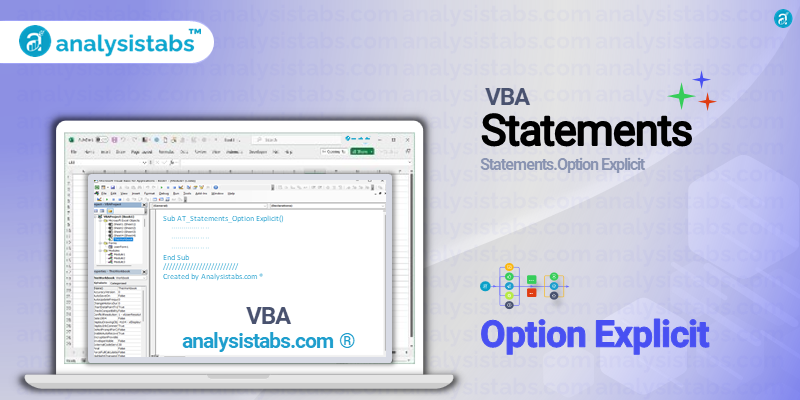When writing code in VBA, it is important to declare variables before using them. This informs the compiler about the data type of the variable and helps in catching any errors that may occur during the execution of the code. The Option Explicit statement is used to enforce this rule and ensure that all variables are declared before their use. In this blog post, we will explore the purpose, syntax, examples, and important notes and remarks of the Option Explicit statement in VBA.
Understanding the VBA Option Explicit Statement
Purpose of Option Explicit Statement
The main purpose of the Option Explicit statement is to enforce variable declaration and prevent the use of undeclared variables in VBA code. This statement was introduced to avoid any errors or inefficiencies in code caused by implicit variable declaration. It also ensures that all variables are properly defined and assigned to a specific data type, making the code more readable and easier to troubleshoot.
Syntax
The Option Explicit statement can be used at the beginning of the module, before any other code. The syntax for using this statement is as follows:
Option Explicit
This statement can be followed by the keyword ‘On’ or ‘Off’, which determines whether explicit variable declaration is enabled or disabled, respectively. By default, Option Explicit is turned off in VBA. However, it is considered a good practice to always turn it on by explicitly writing ‘Option Explicit On’ at the beginning of each module.
Examples of VBA Option Explicit Statement
Simple Example
In the following code, the variable ‘x’ is not explicitly declared, but the code compiles and runs successfully due to the default setting of Option Explicit being turned off.
Sub Example1()
x = 10
MsgBox x
End Sub
However, if we turn on Option Explicit, the code will not compile and produce an error message saying “Variable not defined”.
Option Explicit
Sub Example1()
x = 10
MsgBox x
End Sub
By declaring ‘x’ as an integer, the code will run without any errors.
Option Explicit
Sub Example1()
Dim x As Integer
x = 10
MsgBox x
End Sub
Module-level Example
The Option Explicit statement can be used at the module level to enforce explicit variable declaration for all procedures within that module. It is placed after the module declaration and before any other code.
Option Explicit
Dim x As Integer 'declared at module level
Sub Example2()
x = 10
MsgBox x
End Sub
Sub AnotherExample()
x = "Hello" 'will produce a type mismatch error
MsgBox x
End Sub
Separate Modules Example
The Option Explicit statement can also be used at the beginning of each module to enforce explicit variable declaration, even if they are separate from the main module.
'Module1'
Option Explicit
Sub Example3()
x = 10
MsgBox x
End Sub
'Module2'
Option Explicit
Sub AnotherExample()
y = "Hello" 'will produce a type mismatch error
MsgBox y
End Sub
Option Explicit On vs Option Explicit Off
Turning on or off Option Explicit can affect the functionality and outcome of your VBA code. For example, if we have a variable ‘x’ that is not declared, turning on Option Explicit will produce an error as seen in the previous examples. However, if the variable ‘x’ is declared but assigned a wrong data type, turning off Option Explicit will not produce any errors and will convert the data type to match the declared variable type.
Option Explicit Off
Sub Example4()
Dim x As Integer 'variable declared
x = "Hello" 'variable assigned a string value
MsgBox x 'will display 0 as the value of x
End Sub
It is important to note that turning off Option Explicit can lead to unexpected results and bugs in your code. Hence, it is recommended to always turn on Option Explicit and explicitly declare all variables.
Use of Option Explicit with ‘Dim’ and ‘Static’
The Option Explicit statement can also be used in conjunction with ‘Dim’ and ‘Static’ statements to declare and set variables.
Option Explicit
Sub Example5()
Dim x As Integer 'variable declared and assigned a value
Static y As Double 'variable declared and remains persistent after the sub procedure ends
x = 10
y = 2.5
MsgBox x + y 'will display the sum of x and y
End Sub
Important Notes and Remarks
- Explicit variable declaration using Option Explicit is a good coding practice and can avoid many errors and bugs in VBA code.
- Option Explicit can only catch errors related to variables that have been assigned a value or used in the code. Any variables that have not been used will not produce an error message.
- If the Option Explicit statement is not used, the compiler will automatically create implicit variables with the default data type ‘Variant’ for all undeclared variables. This can cause performance issues and may lead to unexpected results.
- Option Explicit only enforces explicit variable declaration for the current module. To enforce it for all modules in the project, the statement needs to be added to each module.
- Option Explicit has no effect on variables that are declared within a procedure using the ‘Dim’ or ‘Static’ statements.
Conclusion
The Option Explicit statement is a useful tool in VBA that enforces the explicit declaration of variables. This results in more efficient and readable code and helps in avoiding errors and bugs. By using this statement, VBA developers can create more reliable and scalable applications. It is important to always follow this best practice and use Option Explicit in all VBA projects.
Thank you for taking the time to read this blog post on the Option Explicit statement in VBA. I hope you found it informative and helpful.
I would love to hear your feedback and views on this topic. Do you always use Option Explicit in your VBA projects? Have you encountered any issues or benefits by using this statement? Let me know in the comments below.





